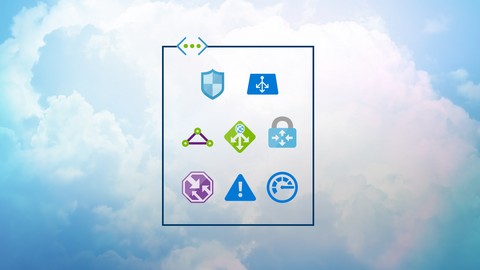
A to Z of Azure Network services – Covers AZ 300, 103 & more
A to Z of Azure Network services – Covers AZ 300, 103 & more, available at $139.99, has an average rating of 4.59, with 66 lectures, based on 1643 reviews, and has 10483 subscribers.
You will learn about Design & deploy virtual networks, subnets Configure network security groups using service tags and application security groups Create user defined routes, multiple NIC's, IP Address configuration Configure availability sets and deploy zone based and zonal based services Configure load balancer for internet load balancing, create NAT rules, configuration of Backend Pools & health probes and monitoring Configure application gateway for URL path based routing, multi site hosting, Web application firewall and monitoring Configure traffic manager with priority, performence, weight and geographic routing methods and use nested profiles Establish peering, point to site, VPN to VPN, site to site VPN connection Connect Azure virtual network with AWS VPC Delivering hybrid applications/solutions network connectivity Use network watcher and network performance monitor to monitor network performance Create and configure Azure Public DNS and Private DNS zones This course is ideal for individuals who are Infrastructure developers or Infrastructure architects or Network specialists & administrators It is particularly useful for Infrastructure developers or Infrastructure architects or Network specialists & administrators.
Enroll now: A to Z of Azure Network services – Covers AZ 300, 103 & more
Summary
Title: A to Z of Azure Network services – Covers AZ 300, 103 & more
Price: $139.99
Average Rating: 4.59
Number of Lectures: 66
Number of Published Lectures: 63
Number of Curriculum Items: 66
Number of Published Curriculum Objects: 63
Original Price: £44.99
Quality Status: approved
Status: Live
What You Will Learn
- Design & deploy virtual networks, subnets
- Configure network security groups using service tags and application security groups
- Create user defined routes, multiple NIC's, IP Address configuration
- Configure availability sets and deploy zone based and zonal based services
- Configure load balancer for internet load balancing, create NAT rules, configuration of Backend Pools & health probes and monitoring
- Configure application gateway for URL path based routing, multi site hosting, Web application firewall and monitoring
- Configure traffic manager with priority, performence, weight and geographic routing methods and use nested profiles
- Establish peering, point to site, VPN to VPN, site to site VPN connection
- Connect Azure virtual network with AWS VPC
- Delivering hybrid applications/solutions network connectivity
- Use network watcher and network performance monitor to monitor network performance
- Create and configure Azure Public DNS and Private DNS zones
Who Should Attend
- Infrastructure developers
- Infrastructure architects
- Network specialists & administrators
Target Audiences
- Infrastructure developers
- Infrastructure architects
- Network specialists & administrators
01 – 08 – 2019: New lectures on Network monitoring ( Network watcher, Traffic analytics & Network performance monitor) and Azure DNS has been added.
Microsoft Azure is the fastest growing cloud platform in the world. One of the key building blocks of Microsoft Azure is its network services. This course is designed to help you to build strong foundation & provide hands on experience in Microsoft Azure network services.
This course covers azure network skills required for AZ 300 and 103 Microsoft certification exams
This course has been designed with an architectural approach. Firstly I will give you an overview of Azure network services architecture and after this introduction, I will take you through following azure services
-
Virtual network & subnets– 10,000 feet overview of Azure Network services; Create virtual networks & subnets and deploy a VM into virtual network.
-
Filter traffic – Network security group – Create network security group(NSG), create inbound & outbound rules, apply them at subnet levels, deploy the virtual machines in subnets and test NSG rules. Configure NSG rules using Application security groups and service tags.
-
Route traffic – NIC, IP Addresses, User defined routes – Understand public and private IP addresses; Network Interfaces; Adding multiple NICs to VM and Multiple IP configurations; Create and configure user defined routes.
-
High availability services –Create and configure availability sets, Zone services and Zonal services.
-
Load balancer – Configuration of frontend IP configuration, backend pool creation, health probes creation, configure load balancing rules, configure NAT rules, automatic reconfiguration & monitoring of the load balancer
-
Application gateway – Creation of application gateway, HTTP traffic load balancing, URL path based routing, multi site hosting, enable web application firewall and test the same, monitoring of application gateway
-
Traffic manager – Creation of traffic manager profile, add end points, load balance traffic based on performance, priority, weight and geographic routing methods.
-
Connectivity scenarios– Configure point to site VPN connection, VPN – VPN connection, Site to site VPN connection, Azure apps connection with VMs on Azure and finally connect Azure virtual network with Amazon web services virtual private cloud
-
Delivering hybrid solutions/applications connectivity – Introduction to App service plan and App service environment; Hybrid applications/solutions connectivity options; Lab demo on P2S VPN connectivity with Azure app service;App service environment connectivity; Introduction to hybrid connections; Lab demo on Hybrid connections and Hybrid connections manager.
-
Network security – Introduction to network security controls, implementation of Azure firewall in hub and spoke model, implementation of network security & application security groups, configuration of service end points and policies, introduction to remote access management options and implementation of Windows Admin centre to remote desktop into Azure VM.
-
Network Monitoring – Introduction to Azure network monitoring and diagnostics; Use Network watcher tools to diagnose network related issues; Introduction to network performance monitor capabilities ; Setup, configure and use performance monitor & service connectivity monitor.
-
DNS – Introduction to Azure Public and Private DNS. Create Azure Public DNS zone and delegate domain into Azure. Create a private DNS and connect virtual networks and create custom domain labels to VMs.
This course contains both theory lectures and a significant number of labs that helps you in gaining hands-on experience in key Azure network related services.
Microsoft Azure is a constantly evolving platform and I will be keep close watch on Azure announcements and add new labs wherever possible.
So, start taking this course and put yourself in high demand in the world of IT and command higher salary!!!
Course Curriculum
Chapter 1: Introduction
Lecture 1: Introduction to the course
Lecture 2: Important lecture on how to improve lectures video quality
Chapter 2: Azure Virtual networks & Subnets
Lecture 1: Introduction to Azure Network Services building blocks
Lecture 2: Introduction to Virtual Network and its capabilities
Lecture 3: Lab demo – Step 1 – Creation of Virtual network and subnets using Azure portal
Lecture 4: Lab demo – Step 2 – Deploy a virtual machine into Azure Virtual network
Chapter 3: Filter traffic – Network Security Groups
Lecture 1: Network Security groups, service tags & application security group overview
Lecture 2: Lab demo – Step 3 – Configure an NSG at Subnet level and VM level
Lecture 3: Lab demo – Step 4 – Configure NSG outbound rules using Service tags
Lecture 4: Lab demo – Step 5 – Configure NSG rule using Application security groups
Chapter 4: Routing Traffic – Network interfaces, Route tables, IP Addresses & VNet peering
Lecture 1: Introduction to Service end points and policies
Lecture 2: Lab demo – Step 6 – Configure service endpoints, policies and resource firewall
Lecture 3: Introduction to Network Interfaces and IP address configuration
Lecture 4: Lab demo – Step 7 – Associate multiple NICs and IP addresses to Virtual Machine
Lecture 5: Introduction to Network routes
Lecture 6: Lab demo -Step 8 – Create user defined route
Chapter 5: Introduction to high availability related Azure services
Lecture 1: Introduction to delivering high availability solution on Azure
Lecture 2: Lab demo – Step 9 – Manage high availability using Availability Zones and Sets
Chapter 6: Azure load balancer
Lecture 1: Introduction to Azure load balancer
Lecture 2: Lab demo – Step 10 – Create Azure load balancer and go through important setting
Lecture 3: Lab demo – Step 11 – Configure Inbound NAT rule to route RDP traffic
Lecture 4: Lab demo – Step 12 – Configure load balancer rule to distribute HTTP traffic
Lecture 5: Lab demo – Step 13 – Configure outbound NAT rule
Chapter 7: Azure Application gateway
Lecture 1: Introduction to Azure Application gateway
Lecture 2: Lab demo – Step 14 – Create and configure application gateway
Lecture 3: Lab demo – Step 15 – Application Gateway URL Path based routing
Lecture 4: Lab demo – Step 16 – Application gateway multi site hosting
Lecture 5: Lab demo – Step 17 – Application gateway web application firewall (WAF)
Chapter 8: Traffic manager
Lecture 1: Introduction to Traffic Manager, Routing methods, Endpoints and monitoring
Lecture 2: Lab demo – Step 18 – Traffic manager performance based routing method
Lecture 3: Lab demo – Step 19, 20 – Traffic manager priority & weight based routing methods
Lecture 4: Lab demo – Step 21 – Traffic manager nested endpoints
Chapter 9: VPN Gateway and connectivity scenarios
Lecture 1: Introduction to VNet connectivity scenarios and VNet peering
Lecture 2: Lab demo – Step 22 – Configure a VNet peering between virtual networks
Lecture 3: Introduction to VPN gateway and connection topologies
Lecture 4: Lab demo – Step 23 – Establish point to site VPN using VPN Gateway
Lecture 5: Lab demo – Step 24 – Establish Site to Site VPN between AWS VPC and Azure VNet
Lecture 6: Express route overview
Lecture 7: Walkthrough of steps to create express route circuit, Peering & VNet integration
Chapter 10: Delivering Hybrid Solution/Applications Connectivity
Lecture 1: Introduction to the section
Lecture 2: Introduction to Azure App Service Plan
Lecture 3: Introduction to App Service Environment
Lecture 4: Hybrid solutions/applications connectivity options
Lecture 5: Lab demo: Establish & test P2S connectivity between App Service and Vnet
Lecture 6: Introduction to App service environment network connectivity
Lecture 7: Introduction to Hybrid connections
Lecture 8: Lab demo: Establish hybrid connection and test the connection
Chapter 11: Network Security
Lecture 1: Overview of Azure Network security controls
Lecture 2: Introduction to DDoS & Azure Firewall
Lecture 3: Lab demo – Implement Azure firewall in Hub and Spoke architecture
Lecture 4: Lab demo – Implement Azure firewall in Hub and Spoke architecture
Lecture 5: Introduction to Remote access management
Lecture 6: Lab demo – Remote access Azure Windows VM using Windows Admin Centre
Chapter 12: Network Monitoring
Lecture 1: Azure Network monitoring & Diagnostics overview
Lecture 2: Introduction to Network watcher & Traffic Analytics
Lecture 3: Lab demo – Walk-through of network watcher tools including Traffic Analytics
Lecture 4: Introduction to Network Performance Monitor
Lecture 5: Lab demo – Setup, configure and use network performance monitor.
Chapter 13: Azure DNS
Lecture 1: Introduction to Azure Public and Private DNS
Lecture 2: Lab demo -Deploy and configure Azure public DNS
Lecture 3: Lab demo – Deploy and configure Private DNS
Chapter 14: Thank you
Lecture 1: Thank you & Bonus lecture
Lecture 2: Virtual network – Lab demos – PDF
Instructors
-
Varma Rudra
TOGAF Certified Enterprise Architect
Rating Distribution
- 1 stars: 14 votes
- 2 stars: 20 votes
- 3 stars: 169 votes
- 4 stars: 573 votes
- 5 stars: 867 votes
Frequently Asked Questions
How long do I have access to the course materials?
You can view and review the lecture materials indefinitely, like an on-demand channel.
Can I take my courses with me wherever I go?
Definitely! If you have an internet connection, courses on Udemy are available on any device at any time. If you don’t have an internet connection, some instructors also let their students download course lectures. That’s up to the instructor though, so make sure you get on their good side!
You may also like
- Best Public Speaking Courses to Learn in March 2025
- Best Affiliate Marketing Courses to Learn in March 2025
- Best Email Marketing Courses to Learn in March 2025
- Best Social Media Management Courses to Learn in March 2025
- Best SEO Optimization Courses to Learn in March 2025
- Best Content Creation Courses to Learn in March 2025
- Best Game Development Courses to Learn in March 2025
- Best Software Testing Courses to Learn in March 2025
- Best Big Data Courses to Learn in March 2025
- Best Internet Of Things Courses to Learn in March 2025
- Best Quantum Computing Courses to Learn in March 2025
- Best Cloud Computing Courses to Learn in March 2025
- Best 3d Modeling Courses to Learn in March 2025
- Best Mobile App Development Courses to Learn in March 2025
- Best Graphic Design Courses to Learn in March 2025
- Best Videography Courses to Learn in March 2025
- Best Photography Courses to Learn in March 2025
- Best Language Learning Courses to Learn in March 2025
- Best Product Management Courses to Learn in March 2025
- Best Investing Courses to Learn in March 2025






















